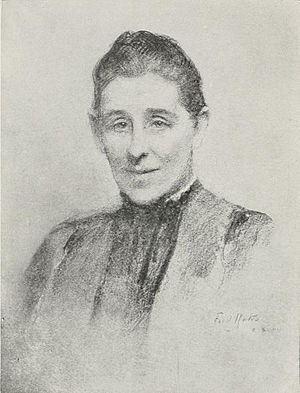Mary Louisa Armitt facts for kids
Quick facts for kids
Mary Louisa Armitt
|
|
|---|---|

portrait by Frederic Yates
|
|
| Born | 31 July 1851 Salford, Lancashire, England |
| Died | 24 September 1911 (aged 60) Rydal, Cumbria, England |
| Nationality | British |
| Education | Manchester Mechanics' Institute |
Mary Louisa Armitt (born July 31, 1851 – died September 24, 1911) was a very talented English woman. She was known as a polymath, meaning she had knowledge in many different subjects. Mary was a teacher, a writer, and an ornithologist (someone who studies birds). She also helped others through her charity work. She is best known for starting and funding the Armitt Library in Ambleside, England.
Mary Louisa Armitt's Life
Mary Louisa Armitt was born in Salford, Lancashire, in 1851. She was one of three very gifted daughters born to William and Mary Ann Armitt. All three sisters loved to write.
They all went to Islington House Academy in Salford. This school taught people how to be teachers. Each sister chose a different main subject to study. Her older sister, Sophia, born in 1847, studied botany (plants) and art. Their other sister, Annie Maria, born in 1850, focused on English literature. Mary, who was often called Louie, was the youngest. She was excellent at music and natural history. When she was old enough, she also studied at the Mechanics' Institute in Manchester. This was a place where working people could learn new skills.
The three sisters were still teenagers when their father passed away. Because they were well-educated, they decided to open a school in Eccles, Lancashire. The oldest student at their school was only a year younger than Mary.
In their free time, the sisters enjoyed going to concerts, art shows, and lectures. They also wrote, drew, and talked about nature. Mary and Sophia even discussed their dreams with a famous writer named John Ruskin. He encouraged Sophia to study art. But he told Mary not to write and to focus on traditional women's activities. Luckily, Mary eventually ignored his advice!
Mary began writing regularly for the Manchester City News in 1877. She also received a scholarship from Trinity College, Cambridge to help with her studies. She became a reader at the Bodleian Library in Oxford, which is a very important library.
One of Mary's special interests was music. She wrote many articles about the history of music. She also worked as a music critic for the Manchester City News newspaper.
In 1886, Mary and Sophia moved to Hawkshead. Their sister Annie was already living nearby. The sisters continued their cultural interests there. They talked with artists, writers, and educators. These included Charlotte Mason and Frances Arnold. Charlotte Mason ran a school for governesses (private teachers). She published a magazine called Parents Review, and Mary wrote articles for it.
By 1894, Annie had become a widow and moved in with her sisters. Mary was very ill with heart problems, which stopped her from traveling far. To help with this, she joined the London Library. In 1897, she published her book, Studies of Lakeland Birds. This book was a collection of articles she had written for the Westmorland Gazette newspaper.
Her Lasting Legacy
Mary Louisa Armitt passed away in Rydal in 1911. She was buried in Ambleside. By the time she died, her personal library had grown quite large. It included two older collections of books. One was from 1828, from the Ambleside Book Club. The famous poet William Wordsworth had been a member of this club. The other collection was John Ruskin's Ambleside library, from 1882.
The Armitt Library was officially opened in 1912. On November 8, 1912, a friend of the Armitt sisters, Canon Hardwicke Rawnsley, read a poem to celebrate. He later helped start the National Trust, which protects important places in England. His poem began:
As in some inland solitude a shell
Still gently whispers of its home, the deep,
So from the world of being beyond all sleep
Where those two happy sister spirits dwell...
The "two happy sister spirits" he mentioned were Mary Armitt, who had died the year before, and Sophia, who had passed away in 1908.
After Mary's death, her book about the history of Grasmere Church was published in 1912. In 1916, Willingham Franklin Rawnsley finished editing Mary's notes on local history. She had researched these notes at Rydal Hall.

